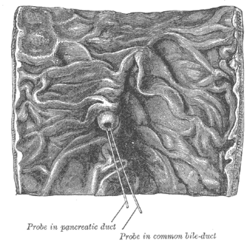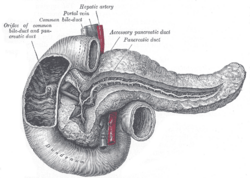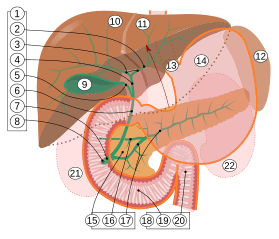Major duodenal papilla facts for kids
Quick facts for kids Major duodenal papilla |
|
|---|---|
 |
|
| Interior of the descending portion of the duodenum, showing bile papilla. | |
 |
|
| The pancreatic duct. | |
| Latin | papilla duodeni major |
The major duodenal papilla (also called the papilla of Vater) is a small, rounded bump inside your duodenum. The duodenum is the first part of your small intestine. This little bump is where two important tubes, the common bile duct and the pancreatic duct, release their liquids into your intestine.
For most people, the major duodenal papilla is the main way that bile and other special liquids called enzymes get into the small intestine. These liquids are super important because they help your body break down and digest the food you eat.
Contents
What is the Major Duodenal Papilla?

9. Gallbladder, 10–11. Right and left lobes of liver. 12. Spleen.
13. Esophagus. 14. Stomach. 15. Pancreas: 16. Accessory pancreatic duct, 17. Pancreatic duct.
18. Small intestine: 19. Duodenum, 20. Jejunum
21–22. Right and left kidneys.
The front border of the liver has been lifted up (brown arrow).
The major duodenal papilla is located in the second section of your duodenum. This is about 7 to 10 centimeters (around 3 to 4 inches) away from your pylorus, which is the opening from your stomach. It's usually found around the level of your second or third lumbar vertebrae (bones in your lower back).
A circular muscle called the sphincter of Oddi surrounds the papilla. Think of this muscle like a tiny door or valve. It controls when and how much of the digestive liquids flow into your duodenum.
The papilla receives a mix of liquids from a small chamber called the Ampulla of Vater. This chamber collects both pancreatic enzymes from the pancreatic duct and bile from the biliary system. The papilla itself sticks out less than a centimeter into the inside space (the lumen) of the duodenum. It looks rounded and often has a small fold of tissue covering its top side.
Another, smaller bump called the minor duodenal papilla is usually found about 2 centimeters (less than an inch) higher up in the duodenum.
How the Papilla Can Be Different
Sometimes, the major duodenal papilla can be in a slightly different spot. For example, in a small number of people, it might be found where the second and third parts of the duodenum meet, or even in the third part itself.
Also, for about 10% of people, the major duodenal papilla might not receive bile. In a few people, the main tube for draining liquids from the pancreas might actually be a different one, called the accessory pancreatic duct.
What Does the Papilla Do?
The main job of the major duodenal papilla is to let pancreatic enzymes and bile flow into your duodenum. These liquids come from both the pancreatic duct and the biliary system.
- Pancreatic enzymes are special proteins that help break down other proteins in your food.
- Bile helps your body digest fats and absorb important fat-soluble vitamins.
Together, these liquids are essential for your body to properly digest the food you eat and get all the nutrients it needs.
Who Discovered the Papilla?
The major duodenal papilla was first drawn and described by a scientist named Gottfreid Bidloo in 1685. However, it is often called the papilla of Vater after a German anatomist named Abraham Vater.
See also
- Common bile duct
- Pancreatic duct
- Ampulla of Vater

